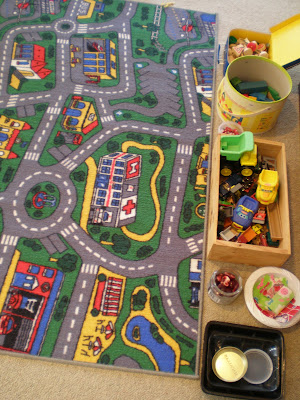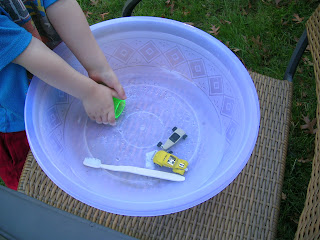Ed has been going through a very challenging phase over the last month or so. In my humble opinion, whoever coined the phrase "terrible twos" was yet to parent a three year old.
What I personally find difficult with head-strong, independent, opinionated yet emotionally immature and irrational three year olds is the fact that it is so hard to get them to listen and co-operate.
My teacher training and years of early-childhood experience have been heavily drawn upon in the last few weeks as I've reflected on our daily lives and routines, re-visited my knowledge about what is developmentally appropriate for this age and gone over what I know about managing behaviour.
I've used a bunch of different strategies to get me through and I finally feel like we're over the worst of it and heading into a new phase.
There's no denying that as children change and grow, they go through difficult stages where, as they re-negotiate their position in the world, they challenge boundaries and test their limits. It's perfectly natural and is to be expected, but I really believe there are things we can do as a parent to make these times a little easier for everyone involved.
Here are some of the strategies I've adopted to encourage Ed to listen and co-operate a little better:
1. Trying to get to the root of his misbehaviour - I read a great book while I was studying called "Understanding Children" by Jeanette Harrison. I've taken a lot from it, but the biggest thing that I've found helpful with both my kids is understanding that children have a motivation for their misbehaviour. It's almost always happening for a reason. When I reflected on Ed not listening and co-operating when I wanted him to, I came to the conclusion that a big reason for him being difficult is the fact that he probably feels a little powerless in his day-to-day life and so he excerpts his power and tries to regain control by defying what he is being asked to do.
So, my first step was to:
2. Give him some choices and decisions that make him feel a little more in control - simple things like letting him choose his clothes, get himself dressed, set the table, choose what flavour juice we buy, where we go in our spare time, choose a meal we have for dinner. All the choices and decisions that are really quite irrelevant when it all boils down, but can mean a lot to a three year old.
Then I:
3. Looked at our weekly schedule - the poor little thing gets dragged to two different playgroups that I run, plus school pick up and drop off every day, plus grocery shopping and errand running. He gets shipped off in the car way more than his sister ever did and it's a lot to cope with when all you want to do is stay home and play with your cars and trains.
So I:
4. Re-organised things so he wouldn't be pulled around so much - my mum came over from Adelaide for a week and stayed with him so he could have a little rest and then I've organised some play dates for him to go on when I work so he's not being dragged along there when he's tired. The school pick up he just has to wear, but I've also tried to organise a few more days at home, just while he's going through this phase.
That means we can:
5. Have a little fun together - by setting up play experiences for him and having times when we laugh together, it's not all nag, nag, nag. He feels valued and important and that way when I ask him to do things, he's in a better mood and more likely to be receptive.
It also means he can:
6. Sleep, sleep , sleep - sleep breeds sleep and he just wasn't getting enough which meant he was getting less rest than he needed and he was tired and cranky. We all know how hard it is to be open and receptive to what people want when we are sleep deprived.
All these things help to limit the behaviour, but I also have a few little tricks up my sleeve for when it still presents itself.
7. Consequences - I use these all the time. It's great if the consequences occur naturally, but if they don't, a logical consequence can be really effective eg. "If you use that as a weapon, I'll have to take it away from you so your sister doesn't get hurt", or "If you are going to run away from me, I'll have to hold your hand, because it's not safe" or "Stand up so I can wash you or I'll have to just get you out of the bath". The consequences should always relate directly to what is going on and I think it's good to ask for what you want a few times before you offer a consequence, that way the child has the opportunity to do what you want without the consequence looming.
8. The timer - for some reason both my kids listen to the timer way more than they listen to me. I guess you just can't argue with an electronic timing device connected to the oven. So, I use it mostly when I want them to change what they're doing and move onto a new part of the routine eg. "When the timer goes, it's time for a bath" or "I'm going to put the timer on for ten minutes, then it's bed time". It works a treat.
9. Breaking tasks down - Ed has trouble coping with more than one to two instructions at a time - as do most children his age. This also means that it's hard for him to break down and attempt tasks on his own. He's finally mastered getting dressed, but I still sometimes need to break it down for him when he's having a bad day. So, instead of saying "It's time to get dressed", I'll say "It's time to get your pants on", then move through each item of clothing until he's done. Similarly instead of asking him to tidy up his room, I'll ask him to put his cars away, then his trains, etc.
10. Some things I don't ask ... - I learnt very early in my teaching career, there are some things you don't ask. It leaves too much opportunity for the answer to be 'no'. So if I really want something done, I don't ask, I assume it will happen eg instead of "Shall we go now?", I'll say "It's time to go" and take his hand.
A very long post I know, but it actually feels good to get this off my chest. It's been a long month, but there's finally some light at the end of the tunnel. Who knew this parenting caper would be such hard work....??





















































